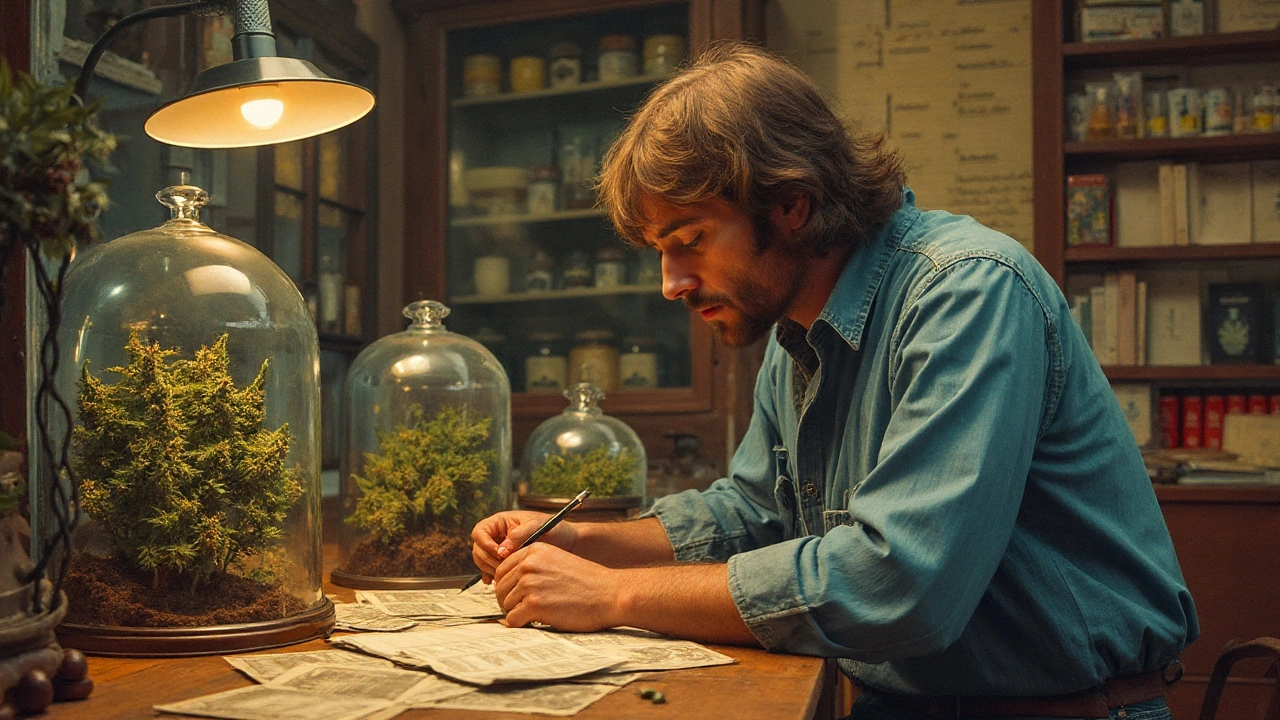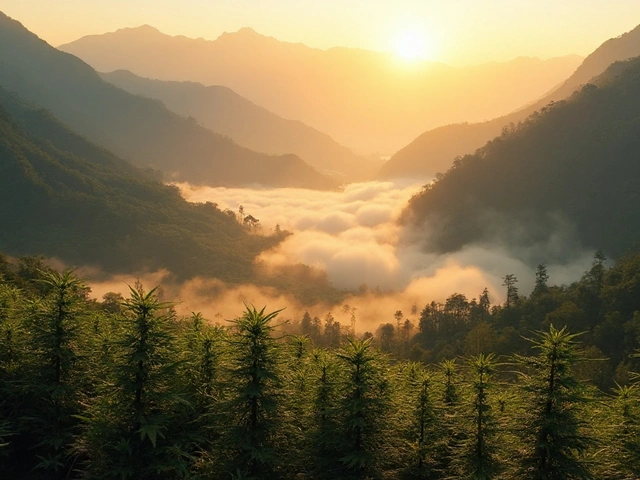Famous Cannabis Strains are a collection of well‑known cultivars that have defined modern cannabis culture through unique genetics, legendary effects, and storied backstories. Enthusiasts often chase these lineages like wine lovers track vintage grapes, because each strain carries a slice of geography, migration, and human ingenuity. Below, we walk through the key chapters that turned obscure landraces into household names.
Landrace Legends: The Roots of Modern Weed
The story begins with true landrace varieties, naturally occurring cannabis that evolved in isolation for centuries. Three of the most influential landraces still echo in today’s hybrids:
- Afghan Kush is a pure indica from the rugged Hindu Kush mountains, known for a deep, sedative body high and THC levels around 15‑20%.
- Thai Sativa is a sun‑kissed sativa originating in Thailand’s highlands, prized for its uplifting cerebral buzz and THC content of 12‑18%.
- Jamaican Lamb's Bread is a sativa‑dominant strain that grew wild in the Jamaican countryside, celebrated for its creative, euphoric lift and THC levels near 14‑20%.
These landraces provided the genetic scaffolding for the 1970s breeding boom, when growers began deliberately crossing them to lock in desired effects and boost potency.
The Golden Era: 1970s‑80s Breeding Explosion
As cannabis culture blossomed in the West, seed banks emerged as the custodians of genetics. Two pioneers- Sewell Seeds and Nevada Seeds-started cataloguing and stabilising hybrids that would become legends.
- Northern Lights is an Indica‑dominant hybrid created in the early 1980s by crossing Thai Sativa with Afghani indica, delivering a smooth, fast‑acting body relaxation and THC near 18‑22%.
- Skunk #1 blended Afghani, Colombian, and Mexican genetics, producing a pungent aroma and a balanced 20‑25% THC profile that set the standard for potency in the 1990s.
- White Widow combined Brazilian Sativa and South Indian Indica, giving a frosty resin coating, a euphoric head buzz, and THC levels of 18‑25%.
These strains were not just popular; they were the genetic workhorses for countless successors, because breeders learned how to stabilise desirable traits while preserving vigor.
Modern Icons: The 2000s‑Present Superstar Strains
With indoor cultivation tech making consistent environments possible, the 2000s saw a surge of creativity. Crosses became more intricate, and branding turned strains into lifestyle symbols.
- OG Kush originated in the early 1990s in Southern California, likely descending from Afghan Kush and a mysterious “Chemdawg” lineage. Its lemon‑pine aroma and 20‑25% THC draw a relaxed, euphoric state favored by both patients and recreational users.
- Blue Dream is a West‑Coast hybrid of Blueberry Indica and Haze Sativa, celebrated for a balanced “head‑body” high and THC ranging from 17‑24%.
- Girl Scout Cookies (GSC) blended Durban Poison, OG Kush, and Cherry Pie, producing a sweet, earthy flavor profile and a potent 18‑28% THC that delivers both relaxation and creativity.
- Durban Poison traces back to South African pure sativa landraces, prized for its clear, energetic high and moderate THC (15‑20%).
These modern icons illustrate how old‑world genetics (Afghan, Thai) can be repackaged through sophisticated breeding to meet today’s market demands for potency, flavor, and consistency.
Terroir and Climate: How Geography Shapes Genetics
Just like grapes, cannabis responds to soil composition, altitude, and sunlight. The Hindu Kush region’s cool, mountainous terrain forces the plant to develop dense resin glands, resulting in the thick, hash‑ready buds we associate with classic indica.
Conversely, the equatorial heat of Thailand encourages tall, lanky growth with airy buds, which translates into the bright, citrusy terpene profiles seen in modern sativas.
Seed banks now track “terroir‑specific phenotypes,” allowing growers to select clones that retain the original climatic fingerprint even when cultivated indoors.

Comparative Snapshot of Selected Famous Strains
| Strain | Primary Type | Origin / Year | Typical THC % | Signature Effect |
|---|---|---|---|---|
| Afghan Kush | Indica | Hindu Kush, 1960s | 15‑20% | Deep body relaxation |
| Thai Sativa | Sativa | Thailand, pre‑1970 | 12‑18% | Uplifted creativity |
| Northern Lights | Indica‑dominant Hybrid | Netherlands, 1980s | 18‑22% | Calm euphoria |
| OG Kush | Hybrid | California, 1990s | 20‑25% | Relaxed happiness |
| Blue Dream | Hybrid | California, 2000s | 17‑24% | Balanced head‑body |
| Girl Scout Cookies | Hybrid | Colorado, 2010s | 18‑28% | Euphoric + soothing |
This table makes it easy to see how geography, breeding era, and cannabinoid levels intertwine to produce distinct experiences. When choosing a strain, consider not just THC, but the lineage that informs terpene aroma and effect profile.
Connected Concepts: From Genetics to Legal Markets
Understanding strain history also means grasping related ideas:
- Indica refers to cannabis that originates from mountainous regions, typically offering sedating body effects.
- Sativa describes low‑land, equatorial varieties known for cerebral, uplifting sensations.
- Hybrid is a cross between indica and sativa genetics, engineered for tailored effect combos.
- Cannabinoids such as THC and CBD determine psychoactive potency and therapeutic potential.
- Terpenes are aromatic compounds (e.g., myrcene, limonene) that modulate flavor and entourage effects.
- Seed Banks preserve and distribute genetics, acting as the custodians of strain heritage.
Each of these concepts links back to the main story: a strain’s lineage determines its chemical makeup, which in turn shapes consumer preference and regulatory classification.
Practical Takeaways for Growers and Consumers
- When selecting a strain, trace its ancestry to gauge expected effects and growth traits.
- Look for reputable seed banks that document phenotype stability; the more transparent the lineage, the less surprise you’ll get.
- Consider terroir‑influenced phenotypes if you’re growing outdoors; a high‑altitude clone may thrive where a low‑land one struggles.
- Pay attention to THC ranges but also review terpene profiles-these often dictate the subjective experience more than THC alone.
By treating famous strains as living histories rather than just brand names, you’ll make smarter choices whether you’re cultivating, prescribing, or simply enjoying.
Frequently Asked Questions
What makes a cannabis strain “famous”?
A strain earns fame through a mix of historic significance, consistent potency, distinctive flavor, and cultural exposure. Legends like Northern Lights or OG Kush have been referenced in music, film, and scientific studies, cementing their status.
How reliable are the THC percentages listed for classic strains?
THC values are averages from multiple lab tests. Genetics, growing conditions, and curing all sway the final number, so expect a range (e.g., 18‑22% for Northern Lights) rather than a fixed figure.
Can I trace the lineage of a modern hybrid back to a landrace?
Most modern hybrids retain at least one landrace ancestor. For instance, Blue Dream’s Haze parent stems from Thai Sativa, while its Blueberry side traces back to Afghan Kush. Seed banks often publish pedigree charts that map these connections.
Why do some strains have multiple names (e.g., GSC vs. Girl Scout Cookies)?
Branding, legal constraints, and regional slang all play a role. "Girl Scout Cookies" was shortened to GSC to avoid trademark issues and to fit dispensary menus. The genetics remain the same.
How does terroir affect the flavor of a classic strain?
Soil minerals, altitude, and climate influence terpene synthesis. Afghan Kush grown at high altitude often exhibits earthier, piney notes, while the same genotype cultivated in a warm indoor setup may lean toward sweeter, citrus aromas.
Whether you’re a curious consumer or a budding cultivator, the cannabis strains history offers a roadmap to better choices and richer experiences. Dive deeper into each lineage, respect the heritage, and enjoy the flavors that centuries of cultivation have crafted.


harvey karlin
September 23, 2025 AT 11:25OG Kush ain't just a strain-it's a vibe. That Chemdawg lineage? Pure alchemy. You can taste the California sun in every puff, and the terpenes? Lemon-pine with a diesel kiss. This ain't weed, it's liquid nostalgia.
Anil Bhadshah
September 24, 2025 AT 21:23Great breakdown! 🙌 Just wanted to add that Thai Sativa is often misunderstood-its high is not just 'uplifting' but deeply clarifying. Many meditators use it intentionally. Also, always check for myrcene levels if you want the body high to kick in faster. 🌿
lili riduan
September 26, 2025 AT 07:53I cried reading this. Seriously. I grew Blue Dream for the first time last year and when that first bud hit the bong… I felt like I was 17 again, sitting on my porch in Oregon, listening to Radiohead. This isn't just science-it's soul. Thank you for writing this.
Trupti B
September 27, 2025 AT 05:25girl scout cookies is the best omg i just wanna eat it like a cookie lol
VEER Design
September 29, 2025 AT 01:34Landraces are the OGs of the plant world. Think of them like ancient manuscripts-each one a handwritten scroll of evolution. When we cross them, we're not just breeding-we're remixing history. Afghan Kush? That’s the Iliad of indica. Thai Sativa? The Beat poetry of cannabis. And now we got GSC? The TikTok viral remix. We lost some soul along the way… but damn, the high’s still divine.
Leslie Ezelle
September 30, 2025 AT 07:33Stop romanticizing landraces. Most of these 'legendary' strains were barely stable in the '80s. Northern Lights? Half the time it was a genetic dumpster fire. And don't get me started on 'terroir'-growers in a closet with LED lights don't give a damn about altitude. This is marketing dressed as mythology. THC numbers? Mostly inflated. Get real.
Mohd Haroon
October 1, 2025 AT 23:21While the historical lineage of cannabis strains is undeniably fascinating, one must not overlook the epistemological framework underpinning the modern commodification of these cultivars. The elevation of 'OG Kush' or 'Girl Scout Cookies' to cultural icons reflects not merely botanical advancement, but a systemic reification of psychoactive consumption as a form of identity performance. The shift from agrarian landraces to corporate phenotypes signals a profound ontological rupture-where the plant’s essence is subsumed by branding, and the consumer is no longer a cultivator, but a client in a curated experience economy. The terpene profiles, once ecological signatures, are now algorithmically optimized for dopamine delivery. We must ask: Are we preserving heritage… or simply packaging it for profit?
Tejas Manohar
October 2, 2025 AT 10:06Thank you for the meticulous research and balanced perspective. As someone who has worked in regulated cannabis markets for over a decade, I can attest that the transparency of lineage documentation remains one of the most critical yet underappreciated factors in consumer safety and product consistency. Reputable seed banks that publish full pedigrees-down to the third filial generation-are the true guardians of botanical integrity. In an industry rife with mislabeling, this level of accountability deserves recognition and institutional support.